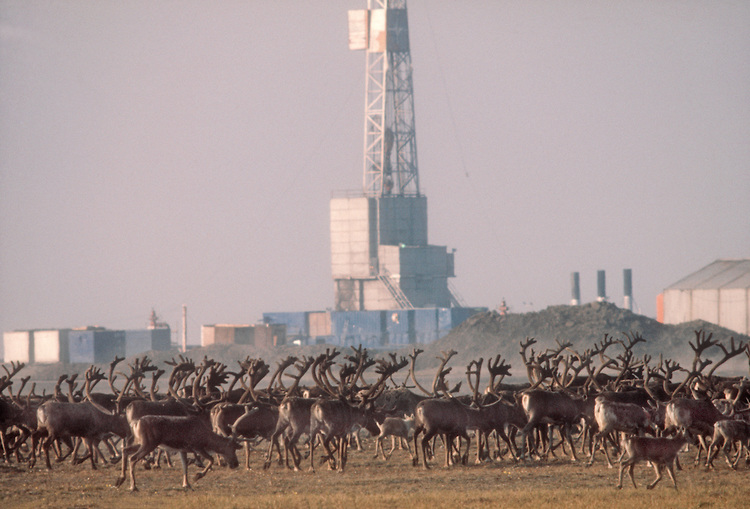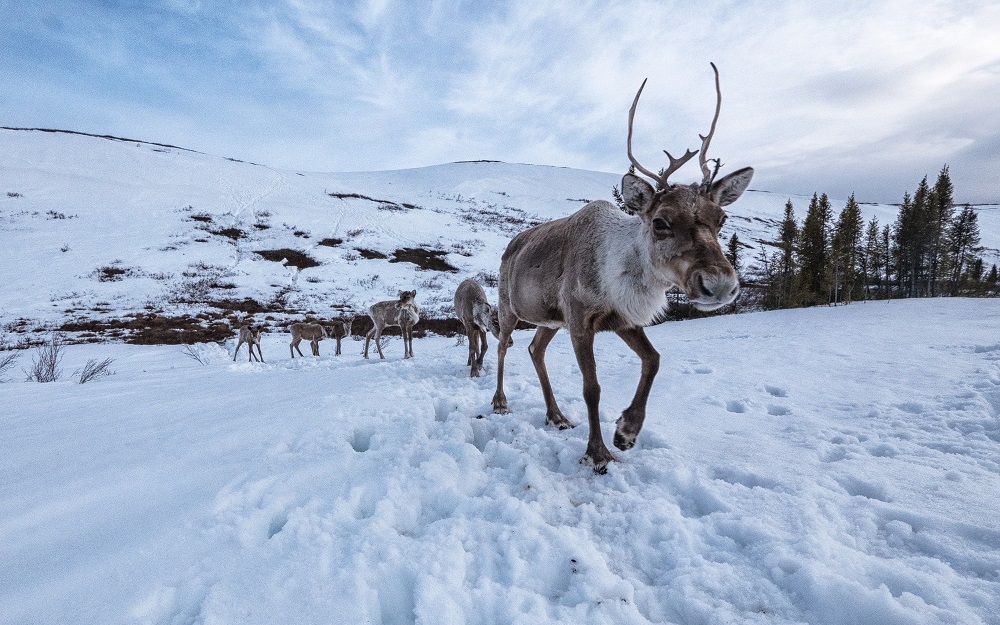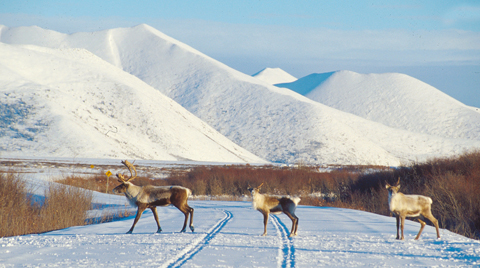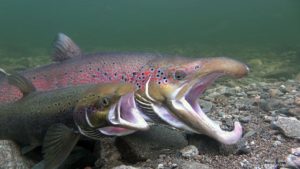
Atlantic Salmon in Kuterra’s on-land fish farm
In late August 2017, a fish farm owned by Cooke Aquaculture allowed more than 300,000 non-native Atlantic salmon escape into the Puget Sound of the Pacific Ocean off the coast of Washington state. Several days passed before a salvage team was hired. The main goal of the salvage team is to create a rapid-response center and encourage recreational fishers to catch as many salmon as possible. Earlier that year, Cooke submitted an application for “replacement and reorientation” of the facility to replace or repair the old-fashion steel cages the previous company had used prior to Cooke buying them out in 2016. The application stated that the system was “nearing the end of serviceable life,” and that repairs were needed in September, after the August salmon harvest (Kim E.T., 2017, para.5). A month before the collapse, Cooke had to complete an emergency repair to stabilize the crumbling facility. The emergency repair was to add extra anchors to the site because old ones had come loose and the site drifted away. Despite these concerns, state and federal agencies were not overly worried and figured the farm would remain stable until September and therefore did not ask them to replace the farm ahead of schedule (Kim E.T., 2017). After the escape incident in August, only about 146,000 of the 300,0000 escaped fish were recaptured (Kim E.T., 2017, para.1). Therefore, more than half of the escaped Atlantic salmon were released into the Pacific Ocean. Typically, Atlantic salmon are known to be more aggressive than Pacific salmon and some of the escaped salmon swam upstream towards spawning areas (Alaska Department of Fish and Game [ADFG], 2017; Kim E.T., 2017). Farmed Atlantic salmon can be identified through a mark left on their ear bone by Cooke aquaculture, and have been identified as far north as Fraser River in British Columbia (Mapes, 2017). Even after losing over 300,000 Atlantic salmon in August, Cooke aquaculture at Puget Sound was granted a permit in October to have one million more Atlantic salmon added to their farm. The only requirement for this permit was that the fish moving from the hatchery to the outside pens carry no disease. Their operation was granted the permit even though their prior escape is still under investigation (Mapes, 2017). Cooke’s main argument for the permit was that they had hatched salmon in their hatcheries and it was biologically time for them to move into the water. This is understandable due to rising demand of fish for consumption over the past few years.

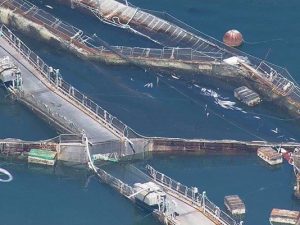
In fact, the seafood industry has grown so much that industrial fishing can no longer support the demands of consumers resulting in the overfishing of oceans (Food and Agriculture Organization [FAO], 2011;World Wildlife Fund [WWF], 2017). Overfishing occurs when so many fish are being captured from the ocean that the species cannot reproductively keep up (WWF, 2017). In 2012, about 21% of fish stocks were considered overfished (National Oceanic and Atmospheric Administration [NOAA] Fisheries, 2013, Table 1).

Just like farms on land that produce cows, chickens and pigs for consumption, fish farms are continuing to pop up in our local waters and are solving the problem of overfishing native populations. Aquaculture, the operation of raising fish commercially, supplies more than 50% of seafood produced for consumption, a number that will continue to rise (NOAA Fisheries, 2017-a, para.7). A report from NOAA fisheries illustrated that in 2015, the fish industry generated $208 billion dollars in sales and supported 1.6 million jobs across the United States (NOAA Fisheries, 2017-b, para. 6). In 2016, fish farms aided in bringing the previous 21% of overfished stocks down to 16% (NOAA Fisheries 2016, Table 2). By farming species that were once overfished, aquaculture facilities allow endangered populations to regenerate themselves (NOAA Fisheries, 2016). While the farmed fish industry continues to grow and reduces overfishing, it consequently poses significant risk to surrounding ecosystems when farmed fish escape and introduce parasites, compete for resources, and interbreed with native species. Between 1996 and 2012 close to 26 million fish were released from aquaculture facilities worldwide, that’s an average of about 1.5 million per year, and that’s just reported escapes (Center for Food Safety [CFS], 2012, Table 1). Fish escapes are common all around the world. For example, in Scotland, The Scottish Salmon Company reported that 300,000 Atlantic salmon escaped on May 21, 2017 (Scotland’s Aquaculture, 2017, pg. 2). The escape was said to be caused by the weather. Similarly, another Scottish company, Scottish Sea Farms ltd., reported that a predator caused 17,398 Atlantic salmon to escape from their farm on March 25, 2017 (Scotland’s Aquaculture, 2017, pg. 1). Furthermore, in 2010, 138,000 salmon escaped from pens in Grand Manan Canada from Admiral Fish Farm ltd. (Canadian Press, 2011, para. 2). President of the company, Glen Brown said that the breach was due to storms that prevented repair for more than four days (Canadian Press, 2011, para. 4). This escape could have been prevented if the regulations in place were upheld and state and national officials mandated the pens were fixed prior to the escape. The regulations in place currently are insufficient, and should be revised to prevent bigger and more detrimental escapes from occurring in the future. So, how can we continue to produce farmed fish while limiting the harmful effects of escape on the ecosystem? By improving legislative requirements on fish farms and increasing the number of on-land aquaculture facilities, the ecosystem will be better protected from escaped fish and the parasites, competition, and gene transmission they produce.
When the spawn of wild salmon hatch, they leave the spawning area and do not return until maturity is reached at around two years of age (Martyal, 2010). In the Broughton Archipelago of Western Canada, from 2001 to 2002, the population of expected spawn to return to the spawning area declined by 97% (Martyal, 2010, para. 2). When the population was examined, 90% of the juvenile wild salmon had contracted sea lice (Martyal, 2010, para. 2). 
Sea lice are parasites that feed on bodies of fish leaving open wounds that are susceptible to disease (Farmed and Dangerous, n.d.). Farmed fish are prone to getting sea lice due to being held in crowded cages, which is an ideal breeding area for lice. Juvenile salmon are most susceptible to getting sea lice since their scales have not fully developed, therefore it is easier for the lice to attach and eat away at their flesh (Farmed and Dangerous, n.d). In 2004, all the fish farms in the Broughton Archipelago area were found to have 29.5 million sea lice (Martyal, 2010, para. 6). When wild juveniles come in contact with infected farmed salmon on their two year journey before returning the the spawning area. This is because most fish farms are found in sheltered water areas along wild salmon migration routes (Farmed and Dangerous, n.d.). The juveniles must make it through 50 miles of fish farms before reaching open water (SeaWeb, 2007). Fishery ecologist from the University of Alberta, Martin Krkosek estimates that sea lice kills more than 80% of the salmon expected to return to their spawning sites (SeaWeb, 2007, para. 1). Additionally, Director of the Salmon Coast Field Station, Alexandra Morton addresses that the juvenile salmon from Broughton must be introduced to sea lice through farmed fish because the parents of the juveniles that carry the parasite are too far offshore (SeaWeb, 2007). Morton also confirms the idea that juveniles are too weak to survive sea lice infections (SeaWeb, 2007). Therefore, it is more than likely that the juvenile salmon are contracting sea lice from nearby escaped farmed fish.
One of the more prevalent issues that arises once large amounts of fish escape from aquaculture pens is competition between wild populations and farm-bred populations. Using salmon as a model organism, we can look further into the issues that arise when aquaculture-bred fish begin to interact with ecosystems originally inhabited by natural, wild fish stock.
First and foremost, dietary competition poses a huge threat of starving out endemic populations of salmon once their farm-bred counterparts emigrate to their habitats. Since the domesticated salmon and wild salmon share the same diet, the arrival of additional organisms to an ecosystem gives rise to the threat of surpassing the carrying capacity of said ecosystem and putting both farmed and wild fish at risk of starvation due to resource depletion (Naylor et al., 2005).
This risk is compounded even further by the nature of farm-bred salmon. Since aquaculture farms select for larger, meat-rich fish, farm-bred salmon have selection pressures in their favor (Bajak et al., 2016). Displaying more aggressive behavior, coupled with their larger biomass, farmed salmon are able to exhibit more fitness in acquiring food than their wild cousins, threatening the natural balance of a fragile ecosystem and causing complete ecological collapse (Naylor et al., 2005; Glover et al., 2016). With roughly 40% of salmon caught off the coast of the Faroe Islands being of farmed origin, the true implications of this new-found competition are only beginning to unfold (Naylor et al., 2005, pg. 427).
Not only do farmed salmon pose a risk of starving out wild salmonids, but they also display invasive behaviors in regards to nesting and foraging grounds, displacing native fish stock to more predated waters, potentially with very little resources (Toledo-Guedes et al., 2014). A study by Van Zwol and associates found data showing that the David’s score (a metric of ecological dominance determined by behavioral analysis) of native salmon dropped when invasive species were introduced to their habitat. This directly resulted in reduced food consumption in the native stock by 40% (Van Zwol et al., 2012, fig. 1). The rise of feral populations of farmed salmonids and the subsequent competition between them and wild stock is a growing concern among ocean ecologists, and is directly tied to decreases in wild salmon population by as much as 50% in recent years (Naylor et al., 2005; Castle, 2017, para. 5).
Similarly, farmed fish can introduce new genes to a native population. When escaped fish mate with their native cousins, populations overtime start to show genetic similarities. Nearly half of the wild salmon population in Norway share about 40% of the gene pool of nearby farmed salmon , showing that the blurring of lines between these two distinct populations is already beginning to unfold (Bajak et al., 2016, para. 3). This may seem harmless, but these traits that are being passed from farmed to wild salmon are not desirable in an open ocean setting. Typically, farmed salmon have a lower fitness and survival rate than wild salmon because they are so used to having their survival needs provided for them by farmers. In this area of weak natural selection, and breeding efforts focused solely on production purposes, domesticated salmon with genetically inherited aggressive behavior put them at increased risk of predation. The same traits that allow farm bred salmon to dietarily out compete wild stock puts them in more danger of being killed by predators (Roberge et al., 2008). When traits are passed on to the hybrid population, they are not as successful as their wild parent and have a greater potential of death. According to the Norwegian Institute of Nature Research and the United Nations Food and Agriculture Organization, by interbreeding native and farmed fish species over two generations there is a significant decline in success, fitness and overall population size (Bajak et al., 2016). A study conducted by Roberge and colleagues, confirms these findings . Roberge compared the level of gene transcription within the genomes of wild and second generation hybrids of wild and farmed salmon. It was found that over 6% of genes had significantly different transcription levels than the first generation cross between the native and farmed population (Roberge et al., 2008, pg. 314). If detrimental genes are propelled into expression by this shock to the genetic system of wild salmon, or if normally functioning genes are overexpressed, the overall fitness of the wild population could exponentially decline. Dr. Christian Roberge, an expert researcher in the field of the effects of salmon hybridization at Laval University claims that this is a serious cause for concern in coming years, as it can lead to population collapse when combined with the other issues highlighted in this paper (Roberge et al., 2008).
Further compounding the damaging effects of interbreeding, the triploidy of hybrid salmon has the potential to majorly contribute to population collapse. Much like mules, horse-donkey hybrids, hybrid salmon possess three sets of chromosomes in comparison to a regular organism’s two, rendering them incapable of reproduction (Fjelldall et al., 2014). Therefore, if a large amount of triploid hybrid salmon are present in a population, mass die offs and subsequent population decreases are inevitable, as the population has no means of sustaining itself if it cannot reproduce at a rate faster than it dies off.
By gene transmission between wild and farmed populations, and the proliferation of triploidy, the overall survival rate for fish in wild ocean environments are declining and causing a deleterious effect on the ecosystem. A successful ecosystem needs high survival rates for it organisms by ensuring specific health needs are met. As Dr. Roberge highlighted in his analysis of the genetic transcription differences between native and farmed salmon, these issues will only compound with time, and can quickly get out of control if we do not do anything to rectify them.
Aquaculture is a complicated system that falls under the jurisdiction of the Environmental Protection Agency along with several other state and federal agencies in the United States (Centers for Epidemiology & Animal Health, 1995). The EPA sets effluent limitation guidelines (ELGs), which restrict the allowable amount of pollution that large Concentrated Animal Production Facilities (CAAP) can produce (Harvard Law School et al., 2012). By the Clean Water Act (CWA) definition, any CAAP that has a “discernible, confined and discrete conveyance… from which pollutants are or may be discharged” is termed a point source polluter (Harvard Law School et al., 2012). The CWA is regulated under the EPA (Harvard Law School et al., 2012).Through the EPA aquaculture facilities are regulated as point source polluters if they produce more than 20,000 (cold water facilities) or 100,000 (warm water facilities) pounds of fish per year and use 5,000 pounds or more of feed per month for at least 30 days per year (Harvard Law School et al., 2012). However, ELGs do not apply to CAAPs that do not fall below these requirements and are instead governed by the National Pollutant Discharge Elimination System (NPDES) (Harvard Law School et al., 2012). Under the NPDES these facilities are required to obtain a permit with specific effluent limitations based off the judgement of the individual writing the permit (Harvard Law School et al., 2012). Therefore, there are no strict guidelines, just the permit writer’s assessment. ELGs can have both numeric and narrative limitations but do not require one or the other (Harvard Law School et al., 2012). While for larger CAAPs, ELGs help regulate the limitation of food input necessary for production, the proper storage of drugs and pesticides, and routine inspections, they do not explicitly address fish escape as a problem (Harvard Law School et al., 2012).
While there are massive ecological consequences to fish escape, the most direct and immediate effect felt by people is the economic damage caused by lost fish. Across six European nations (United Kingdom, Norway, Malta, Ireland, Spain and Greece) over a three year period, 8,922,863 fish escaped in 242 incidents, with over five million of those occurring during two catastrophic events. This accounts for a €47.5 million loss per year, or $56,391,050 (Jackson et al., 2015 , pg. 22). This cost alone is incentive for increased regulations, as solving the fish escape problem would mean cheaper fish for consumers and more profits for the farmers.
Many detractors of legislation would claim that it’s impossible to impose legislation into the mix of a low-profitability production environment such as fisheries. Increasing profitability and employment in the industry all while increasing protection to the environment can seem unattainable, but these are exactly the regulatory goals Norway has adopted in regards to its massive fisheries industry. Despite being the 118th largest country by population, Norway is the world’s 10th largest producer of fish (Årland, & Bjørndal, 2002, pg. 309). By instituting annual quotas for total allowable catches for various species, as well as freezing and sometimes even cutting allowable production in at-risk areas for pathogen transmission, Norway has effectively been able to manage stock populations and detriment to the environment effectively (Castle, 2017). Between 2006 and 2010, fish escapes in Norway decreased precipitously from 290,000 to just 70,000, an over 400% decrease (CFS, 2012, Table 1). This is concrete evidence of the feasibility and efficacy of regulations in the aquaculture industry, and legislators would be wise to follow Norway’s highly successful path.
Cooke aquaculture at Puget Sound is currently under investigation because the Wild Fish Conservancy (WFC) has filed a citizen suit against them under the CWA (Schuitemaker, 2017). The CWA monitors the water quality impacts of aquaculture and any pollutants that are released into the water without a permit (Harvard Law School et al., 2012). The WFC maintains that Cooke should be held accountable because living organisms, like fish that are released into the water, are considered pollutants (Harvard Law School et al., 2012). If the set ELGs for large fish farms do not directly include protection against fish escape and continue to group escaped fish as a pollutant, why would individual perimeters for smaller farms consider it?
Regulations by the EPA should be expanded to include all size farms, and should acknowledge escaped fish separately from other pollutants. Additionally, new and existing regulations should be enforced and recorded more consistently to ensure that new aquaculture facilities are not constantly reinventing the wheel, and can obtain knowledge on running an environmentally and economically conscious facilities (Harvard Law School et al., 2012). If facilities are forced to limit the concentration of fish within a pen, less fish will escape into the open water, should an escape occur. If strict enough regulations, punishments and fines are implemented, few farms could skirt the responsibilities involved with running an ecologically sustainable aquaculture facility and maintain economic feasibility (Thorvaldsen et al., 2015).
Facilities should regularly be inspected by their operating company and the EPA to ensure fish pens are secure and can endure regular weather, tide, and ocean variabilities in the area (Fisheries and Oceans Canada, 2017). Increased inspections would limit the amount of equipment becoming dilapidated to prevent future escapes, like the one that occurred at Cooke aquaculture.
Even if no reprimanding action is taken or required of facilities, all incidents of escape should be recorded and investigated to prevent future incidents from occurring and to be used as guidelines for other facilities so they can avoid making the same errors (Fisheries and Oceans Canada, 2017; Harvard Law School et al., 2012; Scotland, 2017). A list of all escape incidences should be created and updated yearly to ensure an accurate number of escapees is gathered (Scotland, 2017; Fisheries and Oceans Canada, 2017).
While instituting new legislation is a viable solution to preventing environmental issues in regards to fish farms, the costs associated with implementing and enforcing regular inspections, water quality tests, and regulating farm sizes and outputs are considerable and discourage new players from entering the aquaculture industry (McCarthy and River, 2002). Stringent enforcement of these regulations is also absolutely necessary, as many companies simply skirt regulations when they lack oversight due to operational complications, lack of operator education, tight schedules and efficiency initiatives (Thorvaldsen et al., 2015).
In addition to increasing regulation, creating more on-land fish farm facilities will eliminate escape occurrences, and significantly decrease the environmental impacts fish farms have on open water ecosystems (O’Neill, 2017). When possible, moving fish farms to facilities on land could be the solution to preventing fish escape and the myriad of environmental issues mentioned previously that facilities produce in open water environments (Aukner, 2017). This solution readily applies to the majority of fish species, as moving to on-land facilities is a viable and more sustainable option, but for the majority of shellfish, like clams, oysters, and scallops farming in open water can be more beneficial to the environment than destructive by because these species can remove biotoxins, chemical contaminants, and pathogenic microorganisms during their natural process of filtering water for food and other resources (Connecticut Department of Agriculture, 2017). Kuterra, a land based aquaculture facility has had great success in starting an on-land fish farm, and releases documents containing information on the costs associated with on-land fish farming, guides to operating on-land facilities, and the benefits of farming on-land which are valuable to other companies interested in opening facilities (Kuterra, 2014). With the support of multiple national and international companies, their hope and mission is that more farms will open or move on shore in the future and by providing resources future companies can avoid costly trial and error processes (Kuterra, 2014). Several farmed species are marine fish, and therefore require access to saltwater, so on- land facilities are limited by location, needing to stay within several kilometers from a saltwater source in order to operate (Kuterra, 2014).
In order to create a sustainable and economically productive aquaculture industry going forward, regulations must be changed to accommodate greater operational aspects of fish farms. This industry could and should be reshaped to prevent further degradation of the environment without sacrificing economic capacity. Additionally, innovations, such as on-land fish farms, must continue to be proposed and investigated for feasibility and efficacy. The future of mankind’s fisheries is at stake, and pivotal action must be taken to ensure the safety of our seafood supplies. We strongly advise following the advice of the wealth of experts cited in this paper, and implement strict regulations in the vein of Norway’s that regulate density of fish in net pens, total annual production limits and scalebacks, and fines for noncompliance.
AUTHORS
Eleah Caseau, Environmental Science
Jenna Costa, Animal Science, Biotechnology Research
Trevor Klock, Plant and Soil Science
REFERENCES
Alaska Department of Fish and Game (2017). Invasive Species — Atlantic Salmon (Salmo salar) Impacts. Retrieved from http://www.adfg.alaska.gov/index.cfm?adfg=invasiveprofiles.atlanticsalmon_impacts
Årland, K., & Bjørndal, T. (2002). Fisheries management in norway—an overview. Marine Policy, 26(4), 307-313. doi://doi.org/10.1016/S0308-597X(02)00013-1
Bajak, A., Simms, E. L., McDowell, C., Graham, W., & Petit, C. (2016). Into the Wild: When Farmed Salmon Interbreed With Their Wild Cousins. Retrieved from https://undark.org/2016/08/12/muddy-waters-happens-farmed-salmon-go-wild/
The Canadian Press. (2011). 138,000 Farmed Salmon Escape into Bay of Fundy. Retrieved from http://www.ctvnews.ca/138-000-farmed-salmon-escape-into-bay-of-fundy-1.593713
Castle, Stephen. (2017). As Wild Salmon Decline, Norway Pressures Its Giant Fish Farms. New York Times. Retrieved from https://www.nytimes.com/2017/11/06/world/europe/salmon-norway-fish-farms.html
Centers for Epidemiology & Animal Health (1995).Overview of aquaculture in the United States. United States Department of Agriculture: Animal and Plant Health Inspection Service. Retrieved from https://www.aphis.usda.gov/animal_health/nahms/aquaculture/downloads/AquacultureOverview95.pdf
Center for Food Safety. (2012). Reported escapes from fish farms. Retrieved from https://www.centerforfoodsafety.org/files/fish-escapes-chart_14767.pdf
Connecticut Department of Agriculture. (2017). Environmental benefits of shellfish aquaculture. Retrieved from http://www.ct.gov/doag/cwp/view.asp?a=1367&q=478090
Farmed and Dangerous. (n.d.). Sea Lice. Retrieved December 04, 2017, from http://www.farmedanddangerous.org/salmon-farming-problems/environmental-impacts/sea-lice/
Fisheries and Oceans Canada. (2017). Escape Prevention. Government of Canada. Retrieved from http://www.dfo-mpo.gc.ca/aquaculture/protect-protege/escape-prevention-evasions-eng.html
Fjelldal, P. G., Wennevik, V., Fleming, I. A., Hansen, T., & Glover, K. A. (2014). Triploid (sterile) farmed atlantic salmon males attempt to spawn with wild females. Aquaculture Environ Interact, 5 doi:10.3354/aei00102
Food and Agriculture Organization of the United States. (2011). Fish Consumption reaches all-time high. Retrieved from http://www.fao.org/news/story/en/item/50260/icode/
Glover. K.A., Bos, J.B., Urdal, K., Madhun, A.S., Sørvik, A.G. E., Unneland, L., … Wennevik, V. (2016). Genetic screening of farmed Atlantic salmon escapees demonstrates that triploid fish display reduced migration to freshwater. Biological Invasions 18. 1287-1294, doi: 10.1007/s10530-016-1066-9.x
Harvard Law School Emmett Environmental Law & Policy Clinic, Environmental Law Institute, & The Ocean Foundation. (2012). Offshore Aquaculture Regulation Under the
Clean Water Act. Retrieved from http://eli-ocean.org/wp-content/blogs.dir/3/files/CWA-aquaculture.pdf
Jackson, D., Drumm, A., McEvoy, S., Jensen, Ø, Mendiola, D., Gabiña, G., . . . Black, K. D. (2015). A pan-european valuation of the extent, causes and cost of escape events from sea cage fish farming. Aquaculture, 436, 21-26. doi://doi.org/10.1016/j.aquaculture.2014.10.040
Kim, E. T. (2017). Washington State’s Great Salmon Spill and the Environmental Perils of Fish Farming. Retrieved from https://www.newyorker.com/tech/elements/washington-states-great-salmon-spill-and-the-environmental-perils-of-fish-farming
Kuterra Limited Partnership. (2014). Our Story. Retrieved from http://www.kuterra.com/our-story/
Mapes, L. V. (2017). State approves 1 million more farmed fish for Puget Sound, despite escape. Retrieved from https://www.seattletimes.com/seattle-news/environment/state-approves-1-million-more-farmed-fish-for-puget-sound-despite-escape/
Martya1, G. D., & Saksidab, A. S. (2010). Gary D. Marty. Retrieved December 04, 2017, from http://www.pnas.org/content/107/52/22599.full
McCarthy, T., & River, C. (2002). Is fish farming safe? Time Magazine. Retrieved from http://content.time.com/time/magazine/article/0,9171,391523-3,00.html
Naylor, R., Hindar, K., & Fleming, I.A. (2005). Fugitive Salmon: Assessing the Risks of Escaped Fish from Net-Pen Aquaculture. Bioscience 55.5. 427-37, https://doi.org/10.1641/0006-3568(2005)055[0427:FSATRO]2.0.CO;2.
National Oceanic and Atmospheric Administration Fisheries. (2017-a). Basic Questions about Aquaculture: Office of Aquaculture. Retrieved from http://www.nmfs.noaa.gov/aquaculture/faqs/faq_aq_101.html
National Oceanic and Atmospheric Administration Fisheries. (2017-b). NOAA Fisheries Releases Fisheries Economics of the U.S. and Status of Stocks Reports. Retrieved from http://www.nmfs.noaa.gov/stories/2017/04/05_feus_sos_reports.html
National Oceanic and Atmospheric Administration Fisheries. (2016). Status of stocks 2016. Retrieved from http://www.nmfs.noaa.gov/sfa/fisheries_eco/status_of_fisheries/archive/2016/status-of-stocks-2016-web.pdf
National Oceanic and Atmospheric Administration Fisheries (2013). Status of Stocks 2012. Retrieved from http://www.nmfs.noaa.gov/stories/2013/05/05_02_13status_of_stocks_2012.html
O’Neill, E. (2017). In the future, we might farm fish on land instead of in the sea. KCTS9. Retrieved from https://kcts9.org/programs/earthfix/in-future-we-might-farm-fish-land-instead-in-sea
Roberge, C., Normandeau, E., Einum, S., Guderley, H., & Bernatchez, L. (2008). Genetic consequences of interbreeding between farmed and wild atlantic salmon: insights from the transcriptome. Molecular Ecology 17(1). 314-24, DOI: 10.1111/j.1365-294X.2007.03438.x
SeaWeb. (2007). Fish Farms Drive Wild Salmon Populations Toward Extinction. Retrieved from https://www.sciencedaily.com/releases/2007/12/071213152606.htm
Schuitemaker, L. (2017). Lawsuits filed over Cooke Puget Sound salmon escape. Retrieved from http://salmonbusiness.com/lawsuits-filed-over-cooke-puget-sound-salmon-escape/
Scotland’s Aquaculture. (2017). Fish Escape. Retrieved from http://aquaculture.scotland.gov.uk/data/fish_escapes.aspx
Thorvaldsen, T., Holmen, I. M., & Moe, H. K. (2015). The escape of fish from norwegian fish farms: Causes, risks and the influence of organisational aspects. Marine Policy, 55. 33-38. http://dx.doi.org/10.1016/j.marpol.2015.01.008
Toledo-Guedes, K., Sanches-Jerez, P. & Brito, A. (2014). Influence of a massive aquaculture escape event on artisanal fisheries. Fisheries Management of Ecology 21. 113-121, doi: 10.1111/fme.12059
Van Zwol, J., et al. (2012). The effect of competition among three salmonidson dominance and growth during the juvenilelife stage. Retrieved December 05, 2017, from http://onlinelibrary.wiley.com/doi/10.1111/j.1600-0633.2012.00573.x/epdf
World Wildlife Fund (2017). “Overfishing.” WWF, World Wildlife Fund. Retrieved from www.worldwildlife.org/threats/overfishing.


